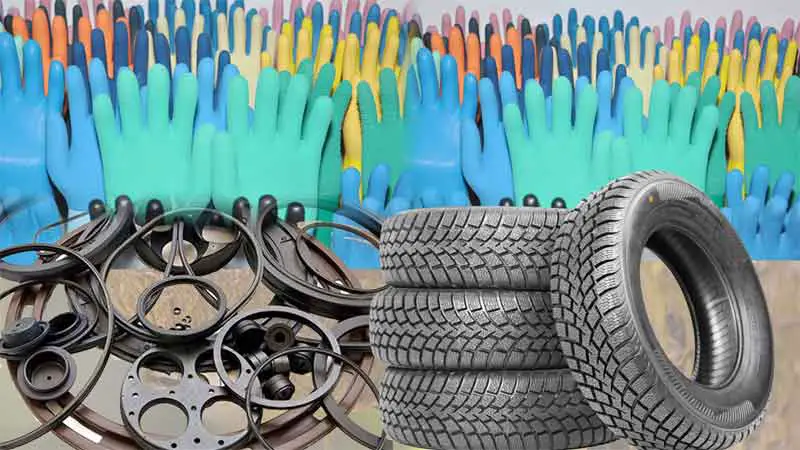The question of how is rubber made and its environmental impact usually has a quick answer, but there are still many unanswered questions.
For example, white rubber or ethylene propylene diene terpolymer that is used to make water hoses.
Plant-based and renewable natural rubbers, such as those derived from the guayule plant, provide environmentally sustainable rubber material that can affect alternative synthetic rubber production.
Factory locations for natural rubber processing are never far from rubber tree plantations for their raw material.
Natural rubber factories can be small to medium-sized. As the demand for natural rubber rises, the environmental impact rises as well.
Manufacturers benefit from rubber materials that can be later manufactured into many products for human use.
Natural rubber processing captures water, energy, chemicals, and hazardous materials such as effluents and wastes. Manufacturers should handle these processes responsibly to reduce environmental damages.
What is sustainable rubber?
Could there be a better way to produce rubber than irresponsible farming methods that lead to deforestation and human rights abuses?
The article “Eco-Business explores the potential for sustainable natural rubber” looks at environmental impact and other production techniques.
Rubber is found in many products, including pencil erasers and birthday balloons. You can find bouncy elastic compressible and moldable rubber in anything from condoms to protective gloves.
Rubber is a natural material made from a milky sap that you can find in the Amazon region. However, demand for rubber has been increasing at a rate of 5% annually. Rubber is now used in automobile tires and aircraft tires.
Meanwhile, as global demands for rubber products grow, more and more tropical forests are losing their native wildlife to the environmental effects of the Rubber Industry.

Environmental Effects of the Rubber Industry
As consumers grow more aware of rubber’s environmental and social effects, companies will need to find new ways to produce sustainable natural rubber that protect forests while still meeting rises in demand.
SNR can be grown in a way that meets these requirements, protecting forests while still providing enough natural rubber at sufficient price points for large industries.
The Eco-Business article looks at how rubber is made and its environmental impact. The article discusses several concerns about rubber production, from purchase to how it affects the climate.
Is Rubber Biodegradable ?
Interest in environmental friendliness in the production of rubber products has become highly sought after.
While there are various types of rubber, it is important to clarify what type of rubber you consider to understand how biodegradable it is.
Have you ever wondered what would happen if synthetic rubber is mixed with natural rubber?
Natural rubber is made from plants, making it biodegradable. This means it decomposes after you throw it away.
As a low carbon emission natural product, despite that, with enough strength, this material is suitable for everything from hoses to rubber bands.
It is believed that rubber use makes up roughly 20% of agrochemical production, including fertilizer.
One-way synthetic rubber can increase littering is by being more biologically constrained. It is less biodegradable and will remain in the environment for a longer period after disposal.
Scientific studies have revealed how rubber’s environmental impact is detrimental to the environment.
Rubber is made from trees that are cut down for leather. Ergo the environment will be negatively affected.
The harmful effects of this are usually not irreversible to cause massive damage, but they are negative.
Rubber is made from the sap of the rubber tree, and while the making of this material has a lower environmental impact than synthetic rubber, it can come with some challenges for water and fishing. When latex comes out of the rubber tree, hundreds of “rubber worms” that stand about 12 inches tall ooze onto the ground below them before receding into their roots.
It implies that fishing spots such as rivers and creeks will find these mounds of rubber emerging from their normal course-
Tires are also a significant problem. Tires are not biodegradable, and in large numbers, tire piles pose a significant environmental risk in landfills across the country.
Considering the environmental impact of multiple production methods, the type of rubber can be a key deciding factor and starting point for your project and products.
Natural Rubber Versus Synthetic Rubber
There are many factors to consider when choosing between natural vs. synthetic rubber. However, both offer advantages and drawbacks.
For example, natural rubber offers higher tensile strength and tear resistance than IR. In addition, natural rubber is less likely to cause allergic reactions than synthetic rubber when in contact with the skin for a long period.
Synthetic rubber may provide more desirable properties such as good heat resistance and an increased lifespan in extreme conditions like high temperature or high altitude.
Environmental Issues Caused by the Rubber Industry
Without proper treatment, wastewater discharge from the rubber processing industry harms the environment and is a big problem.
The natural rubber has many benefits but exudes highly polluted effluents. The rapid growth of the industry is producing serious, long-lasting consequences.
The wastewater discharged from the latex processing usually contains high levels of BOD, COD, and SS. These characteristics vary from country to country because of differences in raw latex and applied technique.
The major source of the pollutants in the coagulation serum, field latex coagulation and skim latex coagulation. These compounds are readily biodegradable. This will cause high oxygen consumption upon discharge of wastewater in receiving surface water.
Process Of Producing Rubber and its Environmental Impact.
The environmental impact of natural rubber is due to how it is made. The effluent from latex coagulation factories is acidic, and the more acid used on the skim latex after centri-fusion, the worse it gets.
Learning how rubber is made from ammonia and exploring its environmental impact!
Making rubber takes resource-intensive chemicals with serious environmental implications. Most latex factories in Thailand don’t have waste management systems to deal with all the compounds. One way is to use a land treatment system, which uses anaerobic wastewater tanks to manage wastewater oxidation better.
The effluent from latex concentrate factories contains high levels of sulfate, which originate from sulfuric acid used in the coagulation process.
The high levels of sulfate inhibit digestion can cause fewer organic materials to be removed. It also causes problems implementing anaerobic treatment systems because of the corrosive environment created by the sulfates.
Problems with Rubber Production and Pollution
Rubber production has some major environmental effects. These include odors like hydrogen sulfide, ammonia, and amines produced by many wastewater treatment processes.
The odor-causing compounds generate a detectable odor at low concentrations and make water unpalatable for hundreds of miles downstream from the rubber plants.
Problems stemming from rubber production vary depending on plant size, raw material used, and several intermediary products.
Can rubber production be environmentally sustainable?
The good news is that rubber can be made quickly on previously cleared land. Rubber trees now growing on these lands can help to capture carbon emissions and reduce erosion.
Making rubber provides a livelihood for millions of people and employees in the industry. If latex production stops, rubber trees can be used in other industries and provide income for workers.
The Sustainable Business Program, spearheaded by WWF and supported by Walmart and Unilever, ensures that companies use sustainable supply chains instead of sourcing material from exploitative sources.
The independent Global Platform for Sustainable Natural Rubber was created in October 2018 to improve its impact on the environment.
The Forest Stewardship Council has developed a position statement on sustainable natural rubber sources to help increase social and environmental benefits.
Conclusion
Finally, it’s right to say rubber is a valuable product needed in modern society. However, rubber poses serious environmental concerns that we cannot ignore.
Producing both synthetic and natural rubber comes with a set of challenges, especially to the environment. Producing natural rubber is a threat to the environment during and after when it’s not properly disposed of.
Some industry players have created recycling rubber to mitigate its negative impact on the environment. Besides, recycling rubber helps ease pressure on its production process.
More consultations should take place to ensure rubber production is sustainable and mitigate its damage to the environment. We have to preserve our environment, and more effort should be directed to sustainable production of rubber.
Besides, industry players should come up with innovative ways of recycling rubber. Manufacturers should initiate campaigns to bring awareness on proper ways of disposing of rubber should also be established to mitigate the environmental impact of rubber.






